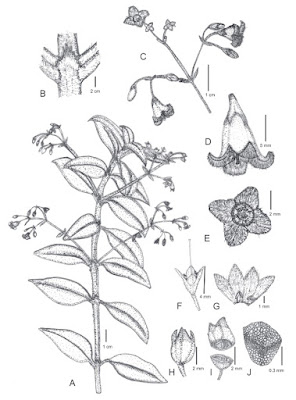 |
| Hedyotis hamiguitanensis Santor, Santiago & Alejandro, in Santor, Santiago, ... et Alejandro, 2021. DOI: 10.36253/jopt-10651 |
Abstract
Hedyotis hamiguitanensis, from Mt. Hamiguitan, Davao Oriental, Philippines, is described, illustrated, and compared with two similar species, H. whiteheadii and H. schlechteri. This species is distinguished from congeneric Philippine species by its 5–12 cm long, compound, umbellate inflorescences, pendulous flowers, lanceolate to oblanceolate, thick, scabrid leaf blades with revolute margins. Its phylogenetic systematic position within the tribe Spermococeae is determined with a phylogenetic analysis using chloroplast (rps16, petD) and nuclear ribosomal (ITS, ETS) nucleotide sequence data.
Keywords: Hedyotis, Rubiaceae, Philippines, taxonomy
Hedyotis hamiguitanensis Santor, Santiago & Alejandro, sp. nov.
Diagnosis: Hedyotis hamiguitanensis is similar to H. whiteheadii and H. schlechteri because of general leaf size ranging from 1.5-4 cm with 3—4 lateral nerves, densely hirsute petioles, and compound peduncled inflorescence, from which it can be distinguished by its lanceolate to oblanceolate, relatively thick leaves, scabrid surface, margins that are entire and revolute, stems, stipules, peduncle, pedicels with hirsute indumentum, inflorescence a com-pound, 5–12 cm long, umbel, and by the pendulous, 8–11 mm long flowers.
Etymology: The specific epithet is based on the type locality, Mt. Hamiguitan, Davao Oriental, Philippines.
Propa Joy R. Santor, Duane Dominic B. Santiago, Conrado Joshua V. Mataga, Elyjha S. Gabriel and Grecebio Jonathan D. Alejandro. 2021. Hedyotis hamiguitanensis (Rubiaceae: Spermacoceae), A New Species from Mt. Hamiguitan, Davao Oriental, Philippines and Its Systematic Position in Hedyotis. Webbia. 76(2); 195-202. DOI: 10.36253/jopt-10651






